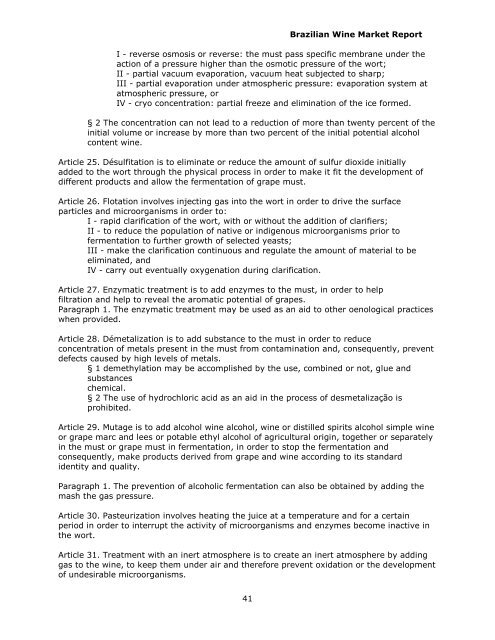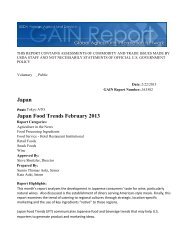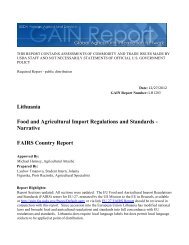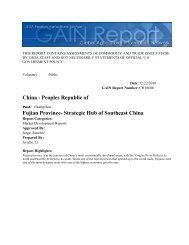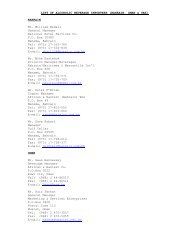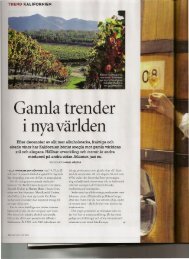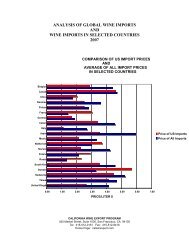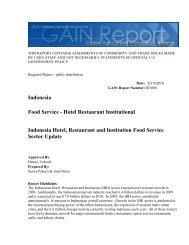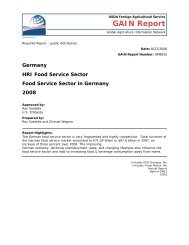Brazil Wine Market Report JBC EMP July 2011 - California Wine ...
Brazil Wine Market Report JBC EMP July 2011 - California Wine ...
Brazil Wine Market Report JBC EMP July 2011 - California Wine ...
You also want an ePaper? Increase the reach of your titles
YUMPU automatically turns print PDFs into web optimized ePapers that Google loves.
41<br />
<strong>Brazil</strong>ian <strong>Wine</strong> <strong>Market</strong> <strong>Report</strong><br />
I - reverse osmosis or reverse: the must pass specific membrane under the<br />
action of a pressure higher than the osmotic pressure of the wort;<br />
II - partial vacuum evaporation, vacuum heat subjected to sharp;<br />
III - partial evaporation under atmospheric pressure: evaporation system at<br />
atmospheric pressure, or<br />
IV - cryo concentration: partial freeze and elimination of the ice formed.<br />
§ 2 The concentration can not lead to a reduction of more than twenty percent of the<br />
initial volume or increase by more than two percent of the initial potential alcohol<br />
content wine.<br />
Article 25. Désulfitation is to eliminate or reduce the amount of sulfur dioxide initially<br />
added to the wort through the physical process in order to make it fit the development of<br />
different products and allow the fermentation of grape must.<br />
Article 26. Flotation involves injecting gas into the wort in order to drive the surface<br />
particles and microorganisms in order to:<br />
I - rapid clarification of the wort, with or without the addition of clarifiers;<br />
II - to reduce the population of native or indigenous microorganisms prior to<br />
fermentation to further growth of selected yeasts;<br />
III - make the clarification continuous and regulate the amount of material to be<br />
eliminated, and<br />
IV - carry out eventually oxygenation during clarification.<br />
Article 27. Enzymatic treatment is to add enzymes to the must, in order to help<br />
filtration and help to reveal the aromatic potential of grapes.<br />
Paragraph 1. The enzymatic treatment may be used as an aid to other oenological practices<br />
when provided.<br />
Article 28. Démetalization is to add substance to the must in order to reduce<br />
concentration of metals present in the must from contamination and, consequently, prevent<br />
defects caused by high levels of metals.<br />
§ 1 demethylation may be accomplished by the use, combined or not, glue and<br />
substances<br />
chemical.<br />
§ 2 The use of hydrochloric acid as an aid in the process of desmetalização is<br />
prohibited.<br />
Article 29. Mutage is to add alcohol wine alcohol, wine or distilled spirits alcohol simple wine<br />
or grape marc and lees or potable ethyl alcohol of agricultural origin, together or separately<br />
in the must or grape must in fermentation, in order to stop the fermentation and<br />
consequently, make products derived from grape and wine according to its standard<br />
identity and quality.<br />
Paragraph 1. The prevention of alcoholic fermentation can also be obtained by adding the<br />
mash the gas pressure.<br />
Article 30. Pasteurization involves heating the juice at a temperature and for a certain<br />
period in order to interrupt the activity of microorganisms and enzymes become inactive in<br />
the wort.<br />
Article 31. Treatment with an inert atmosphere is to create an inert atmosphere by adding<br />
gas to the wine, to keep them under air and therefore prevent oxidation or the development<br />
of undesirable microorganisms.


